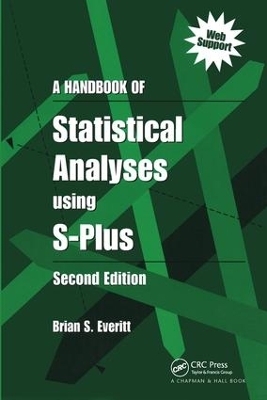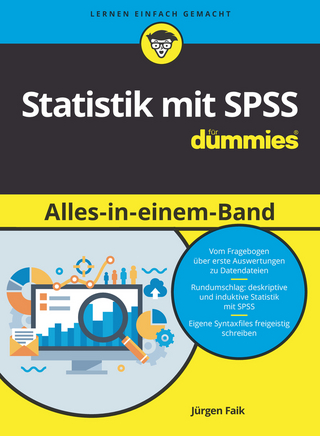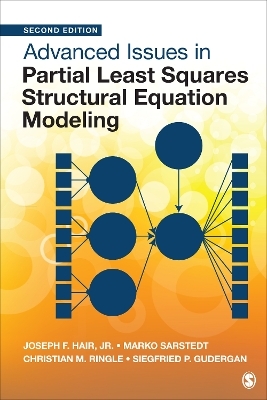
A Handbook of Statistical Analyses Using S-PLUS
Chapman & Hall/CRC (Verlag)
978-1-58488-280-0 (ISBN)
Since the first edition of this book was published, S-PLUS has evolved markedly with new methods of analysis, new graphical procedures, and a convenient graphical user interface (GUI). Today, S-PLUS is the statistical software of choice for many applied researchers in disciplines ranging from finance to medicine. Combining the command line language and GUI of S-PLUS now makes this book even more suitable for inexperienced users, students, and anyone without the time, patience, or background needed to wade through the many more advanced manuals and texts on the market.
The second edition of A Handbook of Statistical Analyses Using S-Plus has been completely revised to provide an outstanding introduction to the latest version of this powerful software system. Each chapter focuses on a particular statistical technique, applies it to one or more data sets, and shows how to generate the proposed analyses and graphics using S-PLUS. The author explains S-PLUS functions from both the Windows® and command-line perspectives and clearly demonstrates how to switch between the two.
This handbook provides the perfect vehicle for introducing the exciting possibilities S-PLUS, S-PLUS 2000, and S-PLUS 6 hold for data analysis. All of the data sets used in the text, along with script files giving the command language used in each chapter, are available for download from the Internet at http://www.iop.kcl.ac.uk/iop/Departments/BioComp/splus.shtml
Everitt, Brian S.
Preface -- Distributors for S-PLUS -- 1 An Introduction to S-PLUS -- 1.1 Introduction -- 1.2 Running S-PLUS -- 1.3 The S-PLUS GUI: An Introduction -- 1.4 The S-PLUS Command Language: An Introduction -- 1.4.1 Elementary Commands -- 1.4.2 Vectors and Matrices -- 1.4.3 Sub setting Matrices and Vectors -- 1.4.4 Other S-PLUS Objects -- 1.5 An Example of an S-PLUS Session -- Exercises -- 2 Describing Data and Assessing Distributions: Husbands and Wives -- 2.1 Introduction -- 2.2 Some Basic Summaries -- 2.3 Analysis Using S-PLUS -- 2.4 Exercises -- 3 Analysis of Variance: Poisoning Rats and Losing Weight -- 3.1 Description of Data -- 3.2 Analysis of Variance -- 3.3 Analysis Using S-PLUS -- 3.3.1 Analysis of Variance of Survival Times of Rats -- 3.3 2 Analysis of Variance of Slimming Data -- Exercises -- 4 Multiple Regression: Technological Changes in Jet Fighters -- 4.1 Description of Data -- 4.2 Multiple Regression Model -- 4.3 Analysis Using S-PLUS -- Exercises -- 5 Logistic Regression: Psychiatric Caseness and Mortgage Default -- 5.1 Description of Data -- 5.2 Logistic Regression and Generalised Linear Models -- 5.3 Analysis Using S-PLUS -- 5.3.1 GHQ Data -- 5.3.2 Mortgage Default Data -- Exercises -- 6 Analysing Longitudinal Data: Beating the Blues -- 6.1 Description of Data -- 6.2 Analysing Longitudinal Data -- 6.3 Analysis Using S-PLUS -- 6.3.1 Summary Measure Analysis of the Depression Data -- 6.3.2 Random Effects Models for the Depression Data -- Exercises -- 7 Nonlinear Regression and Maximum Likelihood Estimation: Athletes and Geysers -- 7.1 Description of Data -- 7.2 Nonlinear Regression and Maximum Likelihood Estimation -- 7.3 Analysis Using S-PLUS -- 7.3.1 Modelling the Olympic 1500-m Times -- 7.3.2 Estimating the Parameters in a Mixture Fitted to the Geyser Eruption Data -- Exercises -- 8 Survival Analysis: Motion Sickness and Bird Survival -- 8.1 Description of Data -- 8.2 Describing Survival Times and Cox’s Regression -- 8.2.1 The Survival Function -- 8.2.2 The Hazard Function -- 8.3 Analysis Using S-PLUS -- 8.3.1 Motion Sickness -- 8.3.2 Bird Deaths -- Exercises -- 9 Exploring Multivariate Data: Male Egyptian Skulls -- 9.1 Description of Data -- 9.2 Exploring Multivariate Data -- 9 3 Analysis Using S-PLUS -- Exercises -- 10 Cluster Analysis: Low Temperatures and Voting in Congress -- 10.1 Description of Data -- 10.2 Cluster Analysis -- 10.3 Analysis Using S-PLUS -- 10.3.1 Clustering Cities in the United States on the Basis of their Year-Round Lowest Temperature -- 10.3.2 Classifying New Jersey Congresspeople on the Basis of their Voting Behaviour -- Exercises -- 11 Bivariate Density Estimation and Discriminant Analysis: Blood Fat Concentration -- 11.1 Description of Data -- 11.2 Bivariate Density Estimation and Discriminant Function Analysis -- 11.3 Analysis Using S-PLUS -- 11.3.1 Bivariate Density Estimation -- 11.3.2 Discriminant Analysis -- Exercises -- Appendix A The S-PLUS Language -- A1 Vectors and Matrices -- A2 List Objects -- A3 Data Frames -- A4 Reading-in Data into S-PLUS -- A5 S-PLUS Functions -- A6 Graphics -- A7 User Functions -- Appendix B Answers to Selected Exercises -- References -- Index.
| Erscheint lt. Verlag | 10.12.2001 |
|---|---|
| Zusatzinfo | 15 Halftones, black and white; 80 Illustrations, black and white |
| Sprache | englisch |
| Maße | 156 x 234 mm |
| Gewicht | 362 g |
| Themenwelt | Mathematik / Informatik ► Mathematik ► Computerprogramme / Computeralgebra |
| ISBN-10 | 1-58488-280-8 / 1584882808 |
| ISBN-13 | 978-1-58488-280-0 / 9781584882800 |
| Zustand | Neuware |
| Haben Sie eine Frage zum Produkt? |
aus dem Bereich


